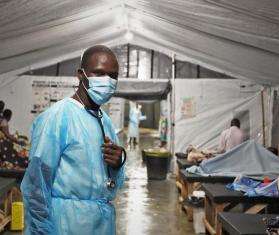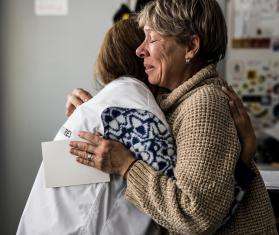South Sudanese refugees fleeing widespread violence in their homeland continue to arrive in Gambella, Ethiopia, after walking for days seeking safe shelter and food. By the end of June 2014, between 600 to 800 refugees were arriving at Burubiey transit camp each day, an increase from the 100 to 300 daily arrivals in previous weeks. Currently more than 140,000 South Sudanese refugees have fled to Gambella since the outbreak of the current conflict in South Sudan in December 2013.
Gambella’s main refugee camps remain very crowded. Plans are underway to expand the new camps of Kule 1 and 2, which have registered 51,476 and 37,287 refugees respectively. The old Leitchuor camp holds an additional 47,469 refugees.
Although proper tents were distributed to refugees in Kule 1, Kule 2, and Lietchuor camps, many people in Kule 1 and Lietchuor still only have pieces of plastic sheeting to protect them from the elements.
New arrivals first stay in transit camps. The Burubiey transit camp, which was overwhelmed in May by an estimated 20,000 people fleeing fighting in Nasir, South Sudan, was emptied in mid-June. Refugees who were living under very difficult conditions were transferred to the permanent camps of Kule 1 and Kule 2. Because of the flooded roads, boats were used to transport the refugees. However, the camp is full again, and a recent influx of refugees are waiting to be transferred to permanent settlements. More than 7,700 refugees are staying at Akobo and Pagak transit camps as well.
Clean water for drinking, washing, and cooking is a critical priority for the crowded camps. Doctors Without Borders/Médecins Sans Frontières (MSF) runs a water treatment plant that produces an average of 1 million liters a day of safe water for refugees. With a daily target of 15 liters per person per day, people in Pagak camp receive the full amount, while those in Kule camp receive 14 liters, in Lietchuor camp, 10 liters, and Kule 1 camp, 8 liters. Sanitation and hygiene are also a priority. MSF has built two-thirds of the 1,200 latrines intended for the camps, and nearly all hand washing points, but so far just 30 of the total 500 showers needed.
In this context, malnutrition is a serious problem. Testimonies by refugees show that many came to Gambella in search of food and safe shelter. “In May, South Sudanese fled because of the fighting,” says Dr. Natalie Roberts, MSF medical coordinator in Gambella. “Now they say they have left their country because of food deprivation."
New arrivals to Kule 1 and Kule 2 camps show up already malnourished. Food distribution in the camps is fragile, forcing many women, for instance, to walk nine kilometers [about 5.6 miles] from Kule 1 camp into town to grind their grain.
Malnutrition rates overall remained high in mid-June: 20 percent for global malnutrition and 6 percent for severe malnutrition. This is an improvement over the previous weeks but still above the emergency threshold of 5 percent of children suffering from severe malnutrition.
Children are also the most vulnerable to illness, contracting respiratory infections, diarrhea, and now malaria because the rainy season has started. Since the end of the measles epidemic in Gambella in May, those who are diagnosed with the disease now are mainly South Sudanese who have just arrived.
Cholera is another risk in the camp because of a current epidemic in South Sudan. MSF expects to launch a vaccination campaign, with the approval of the Ministry of Health, the Administration for Refugee and Returnee Affairs (ARRA), and UNHCR, for a target population of 130,000 people, including refugees and residents.
MSF has conducted 35,361 medical consultations in Lietchuor camp and in Itang since early March and carried out 2,523 medical consultations in Kule 1 and Kule 2 camps in mid-June. During the same period, MSF treated 812 people for malaria in Lietchuor, Itang, Burubiey, Kule 1, and Kule 2 camps, numbers that are likely to increase. MSF also provided care to 1,060 children admitted in the two intensive therapeutic nutritional centers between March and July.
Finally, MSF managed to decrease the mortality rate at its two hospitals in Lietchuor camp (100 beds) and in Itang (130 beds) near Kule camp, respectively, to 11 percent and 7 percent in late June. However, the situation may deteriorate with the rainy season and the surge of related epidemics.
MSF is currently delivering medical care to South Sudanese refugees in Pagak transit camp; Burubiey transit camp; and the three refugee camps of Lietchuor, Kule 1, Kule 2, and Itang. Furthermore, MSF continues to deliver water and sanitation services to Pagak, Kule 1, Kule 2, and Burubiey camps.





